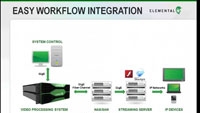Ubiquitous viewing stresses technical backbone
With the development of the high-speed Internet and arrival of a myriad of Web-enabled appliances ranging from laptops to mobile phones, it’s fair to say that television has reached the long elusive goal of on-demand program viewing anywhere, anytime, on any device.
This on-demand trend, however, is putting huge pressures on broadcast and cable technical infrastructures, demanding a massive increase in computing power and increases in the servers to supply a public that wants it all now. Programmers are grappling with many simultaneous issues, including the challenges of dealing with various screen sizes and resolutions, coupled with varying connection speeds that can impact the quality of video playback.
Network speeds to the home or office tend to be much faster than those over mobile networks to phones, computers and other appliances. Yet, how does the provider maintain a presentation of consistent image quality that satisfies all users?
Some argue that massively parallel computing is the answer. This involves both central processing computers at the broadcasters’ main site and graphics processing on the user’s device. The idea is that graphics software on the viewing device can lighten the load on the main computer.

Elemental Technologies last week announced the beta release of a new parallel processing appliance called the Elemental Server. It would reside in the data center of broadcasters, studios, online video platforms and major Web video publishers. It uses multiple GPUs to provide faster-than-real-time transcoding, even for multiple simultaneous 1080p streams.
The Elemental Server has two Intel microprocessors and four NVIDIA graphics chips. The manufacturer said it offers lower encoding costs by achieving the performance of more than 14 quad-core CPUs in a highly cost-efficient 2RU system. The server encodes for H.264 and VC-1 and handles up to eight HD videos simultaneously in real time or produces up to 32 simultaneous 480 x 270 videos in real time.
Video-on-demand services are also dramatically increasing, as are services like Time Warner Cable’s Start Over, which allows viewers to instantly watch the beginning of a program they missed. Several technologies are being used, including hard disks, dynamic random access memory (DRAM) and solid-state Flash memory-based servers. Each storage medium demands optimized software for efficient operation.
Get the TV Tech Newsletter
The professional video industry's #1 source for news, trends and product and tech information. Sign up below.
The dramatic increase in on-demand content is causing some providers to create hybrid server systems, keeping some content local and centralizing other servers. Fiber backbones are used to connect the central storage centers to regional headends.
SeaChange International manufactures Flash-memory-based VOD servers, which use 64 GB solid-state memory cards. Flash memory is often used to serve the most popular content to users, due to cost, while hard drives store less used programming.
Late last year, Buckeye CableSystem, which serves customers in Ohio and Michigan, upgraded to the SeaChange Flash memory server system to help grow its 90,000 subscribers. Buckeye’s most popular VOD content is stored using is SeaChange MediaServer FMS 200 Flash memory-based servers, while less-trafficked material is stored on the company’s HDS 601 hybrid disk-based servers.
The new servers add more than 7000 streams to Buckeye’s VOD capacity, which is managed by a newly deployed version of Axiom On Demand software, SeaChange’s open content delivery platform.
Flash memory has proven fault-resistant and cost-efficient, running on one-tenth the power that hard disks require. “The combination of Flash servers to stream our hottest content, coupled with the hybrid disk servers operating in a centralized capacity, forms an ideal storage and streaming architecture,” said Jim Brown, Buckeye’s director of engineering.
Concurrent of Duluth, GA, provided Flash memory servers for Bright House Networks’ Start Over installations in Tampa and Orlando. Because the time of storage is never more than four hours in Start Over applications, the issue there is frequent ingest and output of content. Flash has proven very reliable in such situations.
Another issue is bandwidth. In order to handle more HD channels and VOD, the need for bandwidth increases. RGB Networks makes high-density video processing equipment that allows cable companies to squeeze more content from their systems.
A single HD stream consumes the same or more bandwidth as four SD streams. With HDTV being a major factor in the competition for video subscribers, RGB has tackled the issue head-on. Its products allow video providers to perform bandwidth optimization in a variety of environments, including broadcast, VOD and switched digital video without costly network upgrades.
RGB’s largest customer is Time Warner. A major investor is Comcast. Together the companies command 50 percent of the U.S. cable market. RGB has the right product at the right time.
However, at the backdrop of all this change in the television industry is a dismal economic condition causing less advertising and an environment where more and more viewing is available for free over the Internet. This loss of income creates a perfect storm of uncertainly in an environment of rapid change.
